The Gilbertsville Academy and Collegiate Institute
My old home town has a lot of great buildings, and this is one of my favorites.
(The Gilbertsville Academy and Collegiate Institute: 1839-1935. This photo is before 1907, and shows the side and back of the building. By this time it was called a high school.)
New England has its tony private schools like Andover, Choate and Philips Exeter, but Otsego County had its own bragging rights for private institutions of fine learning and scholarship. Leading the pack was the Gilbertsville Academy and Collegiate Institute. In a village full of history, it is yet another reason why Gilbertsville was known for miles around as a small, but important center of wealth, commerce, accommodations and learning.
My family’s house in Gilbertsville was on Cliff Street, which after one left the village limits, was technically County Route 4. Many people also called both the street inside and just outside of the village “Academy Hill.” The street branches off from Marion Avenue, just across from the Major’s Inn grounds and winds up a steep hill, passing a large stone building surrounded by ample grounds on the left side of the street. This building overlooks the village below, showcasing a fine view of one of the prettiest villages in Otsego County. This building was the Academy.
I have always found history to be a fascinating subject, especially local history, and Gilbertsville has a wealth of it, especially for a village of such small size. The following is a history of the Academy derived from historical sources, newspapers, village celebration and history booklets, and the National Register of Historic Places report. I know that many people have a much better knowledge and fond memories of activities that took place there, and I welcome your comments. I apologize in advance for any errors or omissions and for an ignorance of recent developments.
When I was around six or seven, I was enrolled in ballet lessons that were given in the school building. Up until 2012, that was one of the very few times I was ever in there. A lot changed since the early 1960s, and little did I know that that stone building, which seemed so big at the time, was one of the most significant buildings in town. I just remember not being all that thrilled with ballet lessons. I do have to admit that I still remember the first through fifth basic ballet positions. Some things never leave you. I wish I had more Academy memories, especially after all I learned about it.
(This photo was taken after 1907, when the building was reduced to two stories and a new rear addition replaced the old.)
Gilbertsville and the surrounding Butternuts villages were settled in the last decade of the 18th century. Even when there were only a few buildings gathering around the Gilbert homestead and what would become a village, settlers were concerned with education. The first school, a wooden building, was built in 1817. This building burned down and was rebuilt in stone. That building is today the Gilbertsville Free Library. It was founded by the generosity of Samuel Cotton, Joseph T. Gilbert, Edward Thorp and John Brewer. A man by the name of Levi Collins was the principal.
Principal Collins must have been an admirable teacher and administrator. The generosity of the school’s patrons and the success of the school itself inspired the townspeople to want to expand and in 1839, fifty-one Butternuts men agreed on paper to donate funds to establish a new and larger school. Each man had the amount he could offer listed, and at the end of the day, they had $2,500 pledged for the new school and its initial endowment. According to an inflation calculator, that sum would be equivalent to almost $66,000 today. That’s a lot of money for its day.
Joseph Gilbert, who donated a full one-fifth of the money, also donated the land making up the grounds, and later had a house built behind it for the school’s principal, which he also donated. Over the years, some students were boarded in the attic rooms. The town wasted no time in building the school, which was christened as the Gilbertsville Academy and Collegiate Institute. The first principal was J. G. Truair. It opened as a private school in the fall of 1840 and may or may not have been co-ed. Most schools of this type and period would have been for boys only.
I was unable to find any definitive information online regarding the student body, although, there were mentions of girls attending the school early in its history. Julia Judson Sheffield Lyon, a village resident, died in 1912. Her obituary mentioned that she “received her early education in the public schools and at the old Gilbertsville Academy.” Since she was born in 1839, one can assume that she was of the age for secondary education in the 1850s. There were other women alumnae as well.
The school was constructed in the Greek Revival style, the most popular architectural style of the day. It was built of local stone, and originally had three stories, a small two-story back extension, and a wooden cupola with a bell tower. The school grounds were spread out all around the building, sloping from the high ground down the hill towards the village.
The school began attracting students from the surrounding counties and towns. The first regent’s report, issued in the fall of 1841 states that the institution had a library of 184 volumes, and “philosophical apparatus” valued at $150. A decade or so later, another $2,500 was raised as the school’s endowment, with an additional $600 given to the school in a bequest.
For the next fifty years, the school flourished as a place of higher education, a preparatory school giving students a leg up in getting into colleges, medical school and places like Princeton, Harvard and Yale. In 1931, then-school attorney said the academy was rated as “the best educational institution in this part of the state.”
Although there was a system of public education in Gilbertsville, the concept of what we think of as “high schools” did not yet exist. Most students received a primary public-school education, learning basic reading, writing and arithmetic, the skills one needed to function in 19th century New York. Private institutions like the Academy took over after that, affording students a secondary education, or as we call it now, a high(er) school.
I perused the local newspapers of the time, many now online, and saw that the Gilbertsville Academy was mentioned often in the 1840s through the end of the century. The academy was well-known and regarded throughout the state. Most of the mentions of its students were of men who attended and/or graduated from the school, many of whom were important and successful people in their fields or endeavors.
One such man was Dr. Theodore White, whose obituary appeared in the Rochester Democrat and Chronicle, on November 19, 1898. “Dr. White was born in Stanford, Conn. In 1834. From there he removed with his parents to Otsego County where he attended the public schools and afterwards the Gilbertsville Academy. After leaving the academy, he entered upon the study of medicine……”
Another entry in the New Berlin Gazette was about William J. Woodlands. The story was about the generations of his family living in Gilbertsville and says: “… after a couple of years of schooling at the Gilbertsville Academy, went to work for his father and became a contractor and master builder.” Mr. Woodlands would go on to be the contractor for the Major’s Inn. There were many, many more, including a fair number of doctors, teachers and lawyers.
Eli R. Clinton was another highly respected Gilbertsville resident. His obituary in The Otsego Farmer in August 1911 read, “When eighteen years of age, he entered Gilbertsville Academy and after securing an education followed the profession of teaching. He was principal of the school at Smyrna and then of the Morris Union School.” Clinton went on to a career as principal of the school in Edmeston, he became town supervisor, the postman and a justice of the peace.
Reports about the school also mentioned a chapel, whether that was in a separate building or wing is unknown. The Stamford Mirror mentions on Christmas Day, in 1883 that the chapel was soon to be provided with an organ. The student body was contributing $28.00 to the fund.
The records for the academy are housed at the Free Library, but unfortunately have not been digitized. I was unable to find out how many students made up the student body. I suspect the entire private school had less than 75 students per semester, the building is not THAT big. An announcement in a local paper at graduation time mentioned that the ceremonies would take place in the chapel, which also would not be able to hold very many students, parents and faculty at once. The graduating class could have been as few as ten to twenty students.

This exclusivity and the size of the school may have contributed to a downturn in enrollment. There were also several financial crises and depressions towards the end of the century, which may also have had an effect. By 1894, enrollment had fallen, so in order to survive, the Academy merged with the Gilbertsville Union Free School. Contrary to the implications of the word “union,” this and other union schools were public, often a union of small communities, and had nothing to do with organized labor.
The merger created an enrollment that was too large for the building. Between 1906 and 1907, the building underwent major changes. The third floor was removed, and a new stone wing was added in the back, as visible in the photo above. A fine new entrance was added to the front of the building, with a deep portico supported by columns. I still wonder how removing a floor of classrooms expanded the building. The new extension doesn’t seem to have adequate square footage.
Joseph T. Gilbert III, who owned the land, had Cliff Street rerouted to give the school the most advantageous location. Houses on the site between the school and Marion Avenue were removed. He also hired a Boston landscape architect to beautify the school grounds and its approach. The architect designed Overlook Park on the site of the old Stag’s Head Inn, which had burned down in the last decade, creating a clear sightline from the Academy, looking at the Major’s Inn, the Gilbert Block buildings and the rest of Commercial Street.
The merger created a public school, it was no longer a private prep school. The new name was the Gilbertsville Union School. Three years later, the Gilbertsville High School was established there and in 1931, both schools were incorporated as the Gilbertsville Central School. Records show that the enrollment in 1931 was 261 students, which rose to 291 in 1933. The school was incredibly overcrowded, but remained the village school until 1935, when the Art Deco-style Gilbertsville Central School was built with Depression-era WPA money.
Since the school was no longer needed, it became vacant and eventually became the property of the Village Improvement Society. It was available for special events, alumni celebrations and gatherings. By the 1950s, it was called Memorial Hall, and the activities continued. My ballet lessons were in the early 1960s, and I remember large open rooms with high ceilings to the right and left of the front door. But when one is 7 years old, most rooms look large, so that memory may not be accurate.
I also remember activities in the building in 1972, for the 150th anniversary of the village. But I went away to college the next year, and never really came back for any protracted length of time. I don’t remember if it was still in use in 1977, when I moved from Gilbertsville to New York City. I was not able to find out when the property became derelict, or when it was purchased by the owner who offered the school and principal’s house for sale in 2012.
Here’s the funny thing about online research. It’s often easier to access records from the 19th and early 20th century than it is to find out about more recent local news. Century old records are often digitized by libraries, universities and even private individuals, but local newspaper morgues are not often online, or have really bad search features. I’m sure someone reading this knows more about that period of time and what was going on.
Anyway, I was looking at real estate listings in early 2012, as a friend and I were planning to move out of Brooklyn. I know they say you can’t go home again, but I wanted to see if I actually could. I knew Gilbertsville had become a popular summer home destination, and a very arty place, but I wanted to see what might be available and for how much. To my surprise, the Academy building was for sale! Along with the house and the acreage around both.
The house really wasn’t what my friend and I were looking for, we really needed a larger place that could easily be divided into some kind of two-family dwelling, but the Academy! I wanted very badly to go back inside. Maybe one of us could have the house, the other (ME!) the Academy. I always wanted to live in a non-traditional building home conversion, and what better than this storied building? The listing was rather vague on the details of the school, and had no photographs of the interior, although they had plenty of pictures of the interior of the house, which was quite nice.
(Interior in 2012. First floor. Photo: Suzanne Spellen)
We drove up to Gilbertsville, the first time I’d been there in a long time, and looked at the property. When we went into the school building, I was gob smacked. It was now a very large garage and storage facility. The owner apparently was in the beginning of some kind of a conversion, as there were framing stud walls downstairs, but mostly, he was using it to hold his vehicles and building supplies. The rooms I remembered from my childhood were long gone, the only thing remaining were rusted tin ceiling panels and some wainscoting. (I would have kept those, btw.)
The second floor was also one large loft, but in better shape, it still had the original floors, most of the tin ceilings, most of the wainscoting and the plaster walls. I was sad that the original rooms, the blackboards, the fixtures were long gone, but I was certainly intrigued by the idea of turning it into the most fabulous home. The building really was a wonderful blank slate for someone to turn into something great, but the cost would have been astronomical. I did daydream about what I would do for many weeks afterward. Looking at the photos now, I can still visualize what I would have done, had I the money to do it.
(The second floor, 2012. Photo: Suzanne Spellen)
I don’t know what happened to the property, it’s long been off the market, but I hope it went to someone who appreciates and understands what they’ve got. They are now not only the owners, but have become stewards of two important Gilbertsville buildings, both of which need to stand for another 200 years. When standing inside, one can still imagine the sounds of students reciting poetry, laughing and running freely outside on the lawn. I can appreciate the memories of those still in town who remember the many activities there, and the hopes that the building would remain what it was intended to be – not only a place of learning but a sentinel, looking over the village of Gilbertsville, as permanent as its stone walls.
View from the front lawn of the Academy, with Cliff Street running past and the Major’s Inn and other buildings beyond. Photo: 2012 real estate listing.)
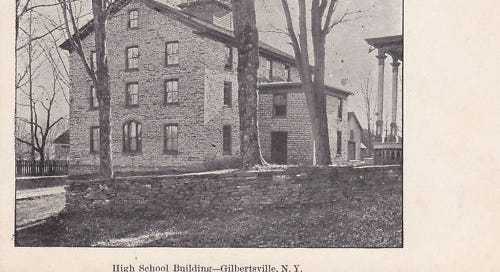



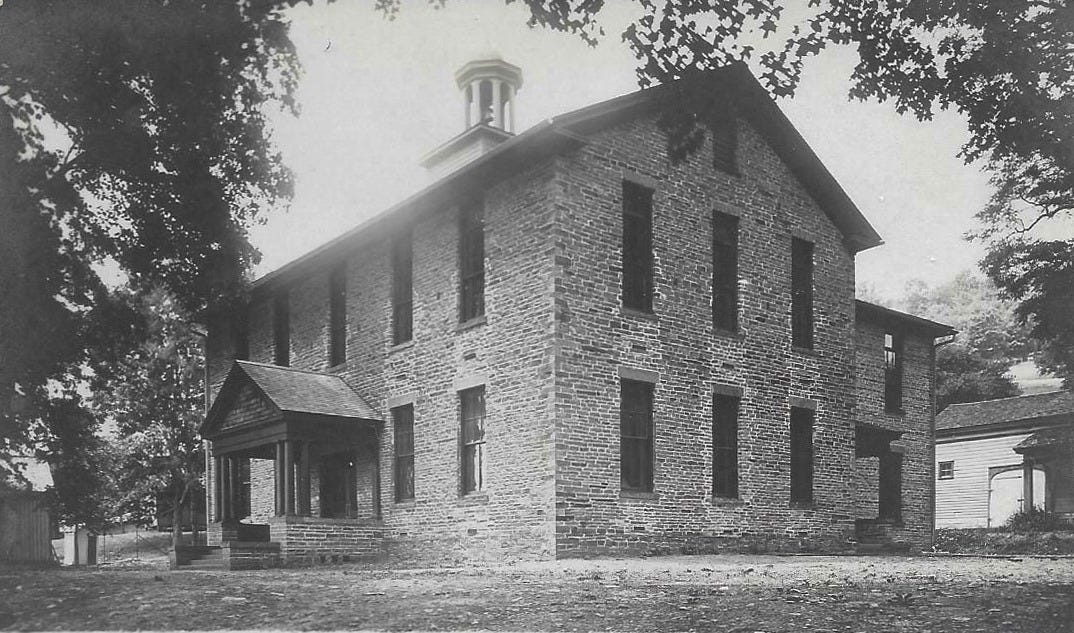
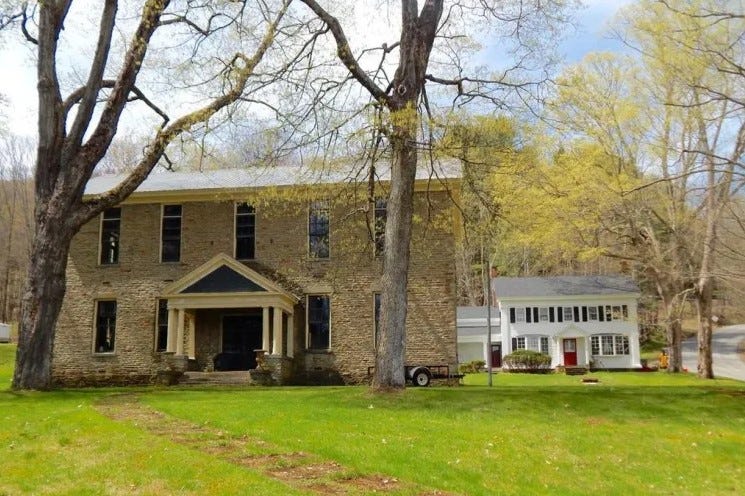
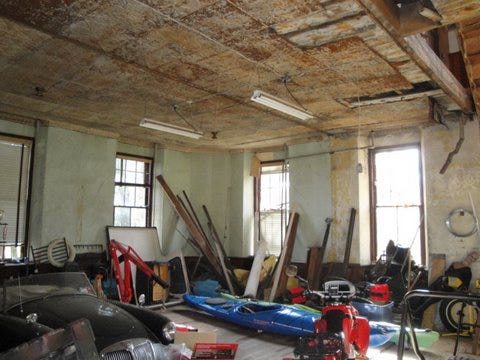
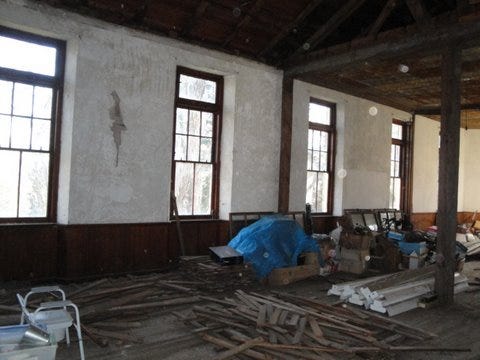
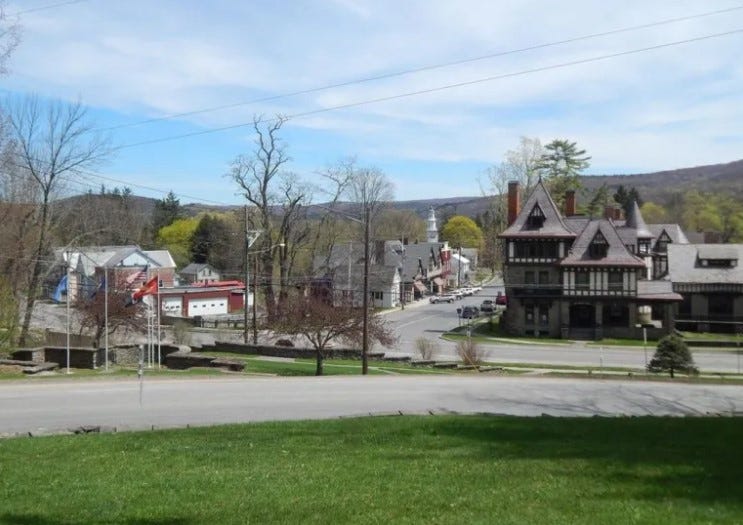
My Grandfather, Raymond Valentine Seaman, came to Gilbertsville with his new bride Gertrude (Wells) in the fall of 1924. He had secured the position of Principal of the Gilbertsville Union School at age 27, having graduated from Syracuse University and taught in Chester, NY. He and Gertrude rented the house attached to the Academy building and promptly had two sons, David and Theodore. My grandfather taught math and science as well as his principal's duties. One favorite family story is that one afternoon my grandmother Gertrude looked out to see her two boys, naked as jaybirds, cavorting on the Academy grounds as students laughed at them from the school windows. She was horrified. My grandfather remained principal as the transition was made to the "new" school. He and his family moved to the house at 1 Sylvan St and expanded to include Philip and Margaret.
I have many photos of the Seaman family at the Academy and of my grandfather posing proudly in front of the new, beautiful, modern school. I also have a copy of very old photo (looks Civil War era to me) of the Academy when it had 3 floors! It appeared that there was some kind of celebration, as the men all have top hats and suits on. Perhaps its 50th anniversary? I will send you these photos at your substack.com address. They did something really odd when they removed the third floor: the windows were extended somehow. I can't figure out what exactly they did.
I believe my grandfather remained principal at the new school until World War 2, when he went into the service. He returned to the Gilbertsville school after the war, and resumed teaching, and may have been principal again at some time after that (not sure.) He was a quiet man, but had a temper. One student in the 1950s recalled that he was called into Mr. Seaman's office after he said something "fresh" to a teacher. Mr. Seaman asked him to repeat what he said, as he threw a piece of chalk up in the air and caught it. The boy repeated his fresh words, fascinated by how high Mr. Seaman was throwing the chalk. As he glanced up toward the ceiling at the chalk, Mr. Seaman suddenly smacked him really hard across the cheek, leaving a red welt. He went back to class with his badge of shame, and 60+ years later recalled it. "Yup, I deserved it." Times were different then.
This was great! I have always wondered about the history of that building!
When I win the lottery, I will give you the Academy to fix up and I will fix up the old art deco school.
Great article! Anytime you want details on Otsego County real estate holdings you can go to this link:
https://otsegocountygis.mapxpress.net/
For the Academy building I found the following information and this person is also listed as owning the house next door. Click on the yellow area to see more details
https://otsegocountygis.mapxpress.net/ags_map/default.asp?MBL=282.05-1-5.00
Dr. White was most likely born in Stamford, CT, not Stanford which is in CA.
All the best,
Bob Thomas